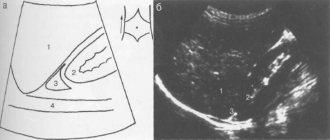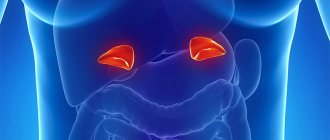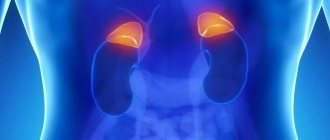The structure and functioning of the adrenal glands
The adrenal glands are based on two structures:
- Brain matter.
- Cortical substance.
They are regulated by the nervous system.
Brain matter
The medulla is the main source of catecholamine hormones in the body - adrenaline and norepinephrine.
Adrenaline is the main hormone in the fight against stress. An increase in its production occurs during positive and negative emotions, for example, during injury or a stressful situation.
When exposed to adrenaline, the body uses reserves of accumulated hormone, which is manifested by the following reactions:
- a sudden surge of strength;
- increased breathing;
- pupil dilation.
The person feels stronger than usual, and the pain threshold is significantly reduced.
Norepinephrine is also a stress hormone, but its production occurs before the production of adrenaline. The impact is much weaker. Its function is to regulate blood pressure, which stimulates the work of the myocardium - the heart muscle.
Cortex
The adrenal cortex consists of several layers, each of which performs a specific function.
- Mesh zone.
- Bundle zone.
- Zona glomerulosa.
Androgens, sex hormones, are synthesized in the reticular zone. They are responsible for the development of secondary sexual characteristics and influence:
- state of libido - sexual desire in men and women;
- blood cholesterol and lipid levels;
- fat deposition;
- increase in muscle strength and mass.
Regardless of gender, each body produces both male and female sex hormones. The difference is in their quantity. For example, women synthesize estrogen and progesterone, which are responsible for reproductive function - conception and birth of children, but also testosterone in a small amount, which is considered the male hormone.
Adrenal glands and gonads
Adrenal glands
Paired glands adjacent to the upper poles of the kidneys. Each adrenal gland consists of a cortex (outer) and medulla (inner).
The hormones secreted by the adrenal cortex can be divided into three groups:
- Glucocorticoids - regulate the metabolism of proteins, fats and carbohydrates
- Mineralocorticoids - regulate water-salt metabolism
- Sex hormones - androgens (male) and estrogens (female)
With hypofunction of the adrenal cortex, Addison's (bronze) disease develops - a serious disease caused by a decrease in the secretion of glucocorticoids. As a result, the metabolism in the body is disrupted, the skin acquires a bronze tint, nausea and vomiting appear, fatigue increases, and patients become exhausted. Without treatment, the disease is fatal.
The adrenal medulla secretes adrenaline and norepinephrine. These hormones increase the rhythm and contractions of the heart, narrow the lumen of blood vessels (and blood pressure increases). In large quantities, adrenaline, the “alarm hormone,” is secreted into the blood during mental arousal (fear, anger), which allows the body to mobilize the energy.
Sex glands
The testes (testes) are the sex glands of men, and the ovaries are the sex glands of women; they belong to the glands of mixed secretion. The presence of testicles/ovaries is the primary sexual characteristic that distinguishes males from females. Hormones secreted by the sex glands cause the appearance of secondary sexual characteristics, which we will study in detail.
Let me remind you that, in accordance with the classification, the sex glands belong to the glands of mixed secretion. In addition to the endocrine section, they have an exocrine section, thanks to which the ovaries release eggs, and the testicles release sperm.
Male gonads
Androgens are synthesized and secreted into the blood in the testes (ancient Greek ἀνδρό - man + γένος - origin).
The main androgen - testosterone - causes the appearance of secondary sexual characteristics, which include: male-type hair growth (increased hair growth on the face, chest and back), more developed muscles, broad shoulders, a narrow pelvis, peculiarities of voice timbre and behavior.
Female gonads
In the ovaries, the synthesis and secretion into the blood of female sex hormones - estrogens (Greek oistros - passion + genēs - generating) - estradiol and progesterone.
Estrogens cause the appearance of female secondary characteristics: roundness of body shape, growth and development of the mammary glands, female-type hair growth (growth of pubic hair, vellus hair on the arms and legs), wide pelvis, and behavioral characteristics.
We especially note progesterone, a pregnancy hormone that is secreted by the cells of the corpus luteum (in the second phase of the menstrual cycle and throughout pregnancy). It prepares the body of the expectant mother for gestation and birth of the fetus: menstruation stops, the growth of the mammary glands increases.
© Bellevich Yuri Sergeevich 2018-2021
This article was written by Yuri Sergeevich Bellevich and is his intellectual property. Copying, distribution (including by copying to other sites and resources on the Internet) or any other use of information and objects without the prior consent of the copyright holder is punishable by law. To obtain article materials and permission to use them, please contact Yuri Bellevich
.
Beam zone
This zone is responsible for the synthesis of glucocorticosteroids. They are responsible for protein, carbohydrate and fat metabolism in the body. Closely related to the production of insulin and catecholamines.
Glucocorticosteroids reduce the immune response, inhibit inflammatory processes, gradually suppressing them.
One of the hormones in the zona fasciculata is cortisol. It takes part in carbohydrate metabolism and preserves the body's energy resources. The level of cortisol in the body is constantly changing - there is more of it in the morning than in the evening or at night.
Zona glomerulosa
The zona glomerulosa of the adrenal cortex is responsible for mineral metabolism in the body. The hormones produced here normalize the functioning of the renal tubules, so excess fluid leaves the body, which, in turn, keeps blood pressure levels normal.
The following hormones are secreted in the zona glomerulosa:
- Aldosterone. Its function is to maintain the balance of sodium and potassium ions in the blood. The hormone takes part in water-salt metabolism, improves blood circulation, and increases blood pressure.
- Corticosterone is a hormone with low activity and is involved in mineral balance.
- Deoxycorticosterone also regulates water-salt balance, gives strength to the skeleton and muscle tissue.
Cortical layer
Also on the topic:
ENDOCRINE SYSTEM
comes from the mesoderm (middle germ layer) of the embryo. The sex glands, the gonads, also develop from the same leaf. Like the gonads, the cells of the adrenal cortex secrete (release) sex steroids - hormones that are similar in chemical structure and biological action to the hormones of the gonads. In addition to the sex hormones, the cortex cells produce two more very important groups of hormones: mineralocorticoids (aldosterone and deoxycorticosterone) and glucocorticoids (cortisol, corticosterone, etc.).
Decreased secretion of hormones from the adrenal cortex leads to a condition known as Addison's disease. Hormone replacement therapy is indicated for such patients (see ADDISON'S DISEASE).
Also on topic:
HUMAN ANATOMY
Excessive production of cortical hormones underlies the so-called. Cushing's syndrome. In this case, surgical removal of the overactive adrenal tissue is sometimes performed, followed by replacement doses of hormones (see CUSHING SYNDROME).
Increased secretion of male sex steroids (androgens) is the cause of virilism - the appearance of male characteristics in women. This is usually a consequence of a tumor of the adrenal cortex, so the best treatment is to remove the tumor.
How do adrenal gland diseases manifest?
When the balance of hormones in the body is disturbed, its functioning occurs. Symptoms appear according to a dependence pattern, that is, a specific substance produced in the adrenal glands is responsible for a symptom unique to it. For example, with aldosterone deficiency, sodium is excreted from the body along with the urine, which lowers blood pressure and significantly increases the potassium content in the blood.
To avoid serious consequences, you need to consult a doctor at the first signs of adrenal disease. These include:
- muscle weakness;
- constant fatigue;
- severe weight loss is a consequence of decreased appetite;
- low stress resistance;
- high irritability;
- rapid and constant fatigue;
- sleep problems;
- dizziness, headaches.
Next, the most common diseases of the adrenal glands, which have their own symptoms and causes, require specific treatment tactics.
Addison's disease
Other names for Addison's disease are primary adrenal insufficiency and hypocortisolism.
A rare pathology, accounting for 50–100 cases per million per year. It is diagnosed in both women and men. Average age is from 20 to 40 years.
The disease affects all three zones of the adrenal cortex. Characterized by a deficiency in the production of corticosteroids. Violation of hormone synthesis causes serious complications in the body.
The cause of destruction of the adrenal cortex is pathogenic microorganisms that have entered the body - viruses, bacteria, fungi, as well as immune disorders.
Manifestations of Addison's disease:
- decreased blood pressure;
- fatigue, weakness, lack of physical strength;
- lack of appetite;
- disruption of the digestive system;
- pigmentation of the skin, the appearance of dark spots on the mucous membranes;
- chills;
- increase in body temperature.
To identify the disease, it is necessary to take tests to measure the level of cortisol in the blood. The condition of the adrenal cortex and the functioning of the glands are examined.
Treatment is taking medications containing corticosteroids throughout life. It is possible to administer hydrocortisone intramuscularly.
Indications
Signs of a malfunction of the adrenal glands may include:
- the appearance of fat deposits in the abdominal area with relatively thin arms and legs,
- stretch marks, rashes, skin hyperpigmentation,
- hair loss on the head, male pattern body hair in women,
- urinary disorders,
- high blood pressure,
- weight loss,
- cramps, decreased muscle tone,
- increased fatigue, weakness for no reason.
If at least one of the above symptoms appears, you should undergo laboratory diagnostics of the endocrine system. Your doctor will tell you what tests you need to take to check the functioning of your adrenal glands.
Itsenko-Cushing's disease
Refers to neuroendocrine pathologies. The reason is a malfunction of the hypothalamic-pituitary system as a result of brain injury or infections suffered by a person. Characterized by the production of excessive amounts of corticosteroids by the adrenal glands.
Itsenko-Cushing's disease is a rare pathology. It is diagnosed mainly in women aged 30 to 45 years.
A malfunction in the hypothalamic-pituitary system provokes disturbances in the body. The connection between the adrenal glands, hypothalamus and pituitary gland is lost. Signals sent to the hypothalamus provoke excess production of hormones that release adrenocorticotropic hormone (ACTH) in the pituitary gland, which stimulates the release of the substance into the blood. Excessive amounts of ACTH affect the adrenal glands, which begin to increase the production of a lot of corticosteroids.
As the pathology progresses, there is a visible increase in size of the pituitary gland and adrenal glands.
Signs of Itsenko-Cushing's disease:
- headaches, migraines;
- progressive hypertension;
- amyotrophy;
- formation of a moon-shaped face;
- lack of menstruation in women;
- development of osteoporosis;
- facial hair growth in women.
To identify the disease, blood and urine tests are prescribed, which determine excess amounts of ACTH and cortisol. Additionally, an instrumental examination is carried out.
The goal of therapy is to restore impaired metabolism, normalize the functioning of the hypothalamus, and normalize the synthesis of corticosteroids.
Medulla
originates from the sympathetic ganglia of the embryonic nervous system. The main hormones of the medulla are adrenaline and norepinephrine. Adrenaline was isolated by J. Abel in 1899; it was the first hormone obtained in chemically pure form. It is a derivative of the amino acids tyrosine and phenylalanine. Norepinephrine, the precursor of adrenaline in the body, has a similar structure and differs from the latter only in the absence of one methyl group. The role of adrenaline and norepinephrine is to enhance the effects of the sympathetic nervous system; they increase heart and breathing rates, blood pressure, and also affect the complex functions of the nervous system itself. See also HORMONES; CORTISOL.
Pheochromocytoma
Pheochromocytoma is a tumor that develops in the adrenal medulla. It is based on chromaffin bodies, which contribute to the synthesis of large amounts of catecholamines.
The cause is arterial hypertension and catecholamine crises.
Symptoms of pheochromocytoma:
- high blood pressure, hypertensive crises;
- headache;
- increased sweating;
- dyspnea;
- dehydration of the body;
- convulsions;
- cardiomyopathy;
- high blood sugar.
To diagnose the disease, tests are prescribed to determine catecholamine metabolites in the urine and blood. To identify the formation, hardware methods are used - MRI and ultrasound scanning.
Treatment is medicinal, aimed at reducing the severity of paroxysmal attacks.
Adrenal medulla
The medulla is located in the center of the adrenal gland and makes up no more than 10% of its mass. It is important to note that the adrenal medulla and the adrenal cortex are completely different structures in origin. The adrenal cortex is of ectodermal origin. The adrenal medulla is derived from the primary neural crest.
Adrenal medulla cells synthesize catecholamines - norepinephrine and adrenaline.
The main function of adrenal medulla hormones is to increase blood pressure, enhance heart function, expand the lumen of the bronchi, and influence metabolic processes in the body.
Hyperaldosteronism
Another name for the pathology is Kohn syndrome. A condition in which the adrenal cortex produces excessive amounts of aldosterone and deoxycorticosterone.
The causes of hyperaldosteronism are a malignant formation in the adrenal cortex or hyperplasia of cortical tissue.
Kohn syndrome has primary and secondary degrees of development. Symptoms of the primary degree of the disease:
- increased blood pressure;
- headache;
- heart rhythm disturbance;
- cardialgia – pain in the left side of the chest;
- decreased visual acuity.
Secondary symptoms result from excess potassium and sodium deficiency:
- swelling;
- chronic renal failure;
- fundus deformation;
- arterial hypertension.
Diagnostic measures include determining the level of potassium and sodium, aldosterone in the blood and urine.
Therapy depends on the results of the examination. More often this is drug treatment with the prescription of hormonal drugs. If a tumor is present, surgery may be performed.
Diagnosis of adrenal obesity
The difficulty in making a correct diagnosis lies in the fact that increased cortisol also occurs with normal (dietary) obesity. In some patients, even in the presence of a benign tumor, its level does not change in the bloodstream, since it predominantly accumulates in adipose tissue and is destroyed by the liver. Therefore, if the Cushingoid type of fat distribution is typical or other symptoms of hypercortisolism are present, several tests are prescribed:
- cortisol in daily urine;
- hormone levels in saliva and blood several times a day;
- tests with dexamethasone;
- analysis of morning urine for 11-hydroxyketosteroids and 17-ketosteroids;
- general blood test, biochemistry, electrolytes, lipid profile.
In order to exclude an adrenal tumor or proliferation of the cortex, ultrasound and tomography are prescribed. To examine the pituitary gland, a contrast-enhanced MRI is necessary, since corticotropin-producing adenomas are often small.
Hyperplasia of the adrenal cortex
This is an increase in the size of the adrenal cortex, which leads to increased synthesis of androgens. The main reason is genetic, that is, the disease is congenital.
There are three main forms of hyperplasia:
- Simple virilizing. There is an increase in the synthesis of androgens, as a result of which the genitals and muscle tissue become enlarged, and hair grows rapidly all over the body, regardless of the gender of the sick person.
- With salt loss syndrome. Characterized by excess potassium and deficiency of other hormones.
- Hypertensive. Excessive production of androgens and corticosteroids occurs, as a result of which arterial hypertension develops and visual function deteriorates.
Symptoms of adrenal hyperplasia:
- early hair growth on the body and genitals;
- growth is less than normal;
- rough voice;
- memory problems;
- frequent psychoses;
- weakness of the muscular system.
Signs appear in childhood. To clarify the diagnosis, tests and laboratory tests are prescribed.
Treatment is medicinal and includes constant use of hormonal drugs. In severe cases of the disease, surgical intervention is indicated.
Obesity with problems with the adrenal glands
Characteristic signs of excess weight of adrenal origin are:
- thin limbs with reduced muscle mass;
- fat deposition in the abdomen, chest, back;
- smoothing the pits above the collarbones;
- the appearance of a bulge above the seventh cervical vertebra;
- moon-shaped face - plump cheeks, often with a bright blush.
This type of distribution of adipose tissue is called Cushingoid. It is found in 90% of cases with Itsenko-Cushing syndrome. In this case, obesity is the first or even its main manifestation. In children and some adult patients, fat is distributed evenly throughout the body.
You can suspect adrenal disease in obesity based on the following signs:
- the appearance of purple stretch marks on the skin of the chest and abdomen;
- increased capillary fragility and frequent bruising on the skin;
- high blood pressure;
- women have a tendency to decrease blood discharge during menstruation and their occurrence more rarely, excess hair growth on the body and face, greasy skin, acne, partial baldness;
- men are characterized by sexual weakness and low sexual desire, decreased testicular volume;
- lethargy, constant malaise, low performance, depressive states, mental disorders.
Adrenal insufficiency
This is a dysfunction of the adrenal glands of an autoimmune nature. There are two types - acute and chronic.
Chronic insufficiency of the adrenal cortex occurs as a result of destructive changes in the glandular tissues of the organ. The main causes are previous infectious diseases, a pituitary tumor or macroadenoma, necrosis or inhibition of the anterior lobe of the pituitary gland.
The acute form develops against the background of the chronic form. It almost never occurs on its own, with the exception of sepsis or sudden hemorrhage in the adrenal glands.
Symptoms of adrenal insufficiency:
- weakness, constant loss of strength;
- loss of appetite, resulting in a sharp decrease in body weight;
- hyperpigmentation of the skin;
- arterial hypotension;
- decreased blood sugar levels;
- frequent urination;
- nausea turning into vomiting;
- uncharacteristic stool.
Adrenal diseases
The adrenal glands are paired glands directly adjacent to the upper poles of the kidneys.
This endocrine organ is of vital importance.
Adrenal hormones are responsible for adaptive and protective mechanisms, ensure the body’s survival under conditions of stress and increased stress, are responsible for the level of blood pressure and vascular resistance, regulate water and electrolyte balance, determine the body’s response to allergens and inflammatory processes, participate in the regulation of metabolism, synthesis collagen and the functioning of the reproductive system. Diseases of the adrenal glands, like any other endocrine organs, can manifest themselves as either an increase or decrease in the production of their own hormones. In this case, the pathological process may be limited by a violation of the synthesis of one or several adrenal hormones.
In this regard, complaints from patients with diseases of these organs can be very diverse and include
:
- weight gain or loss (with Cushing's syndrome or chronic adrenal insufficiency)
- increased or decreased blood pressure (with pheochromocytoma, Conn's syndrome or Addison's disease)
- attacks of palpitations and fever (with pheochromocytoma)
- abdominal pain, nausea and vomiting (with pheochromocytoma, adrenal insufficiency)
- weakness and loss of strength (with chronic adrenal insufficiency)
- darkening of the skin or the formation of stretch marks (with Addison's disease or Cushing's syndrome)
- characteristic redistribution of adipose tissue with changes in appearance (with hypercortisolism)
- muscle pain, paresis and paralysis (with primary hyperaldosteronism)
- excess hair growth and alopecia (with disorders of sex steroid production) and much more
Due to the non-specific nature of complaints in many diseases of the adrenal glands, such patients, as a rule, do not turn to a specialized specialist (endocrinologist), undergo unnecessary examinations and receive inadequate treatment. It is important to note that when a patient treats diseases of the adrenal glands, the doctor is required to have certain knowledge that allows him to combine disparate symptoms into a single diagnostic concept of endocrine disease and prescribe an adequate examination.
As a rule, a simple laboratory determination of the level of adrenal hormones is not enough. This is important to know. These tests become informative only under certain conditions, during diagnostic tests, including with the introduction of a number of pharmacological drugs.
The specialists of the Rassvet clinic constantly expand and update their skills in the field of diagnosing functional disorders of the adrenal glands, which allows them to effectively, reliably and cost-effectively make the correct diagnosis and recommend treatment.
Inflammation of the adrenal glands
Inflammatory processes in the adrenal glands most often occur against the background of tuberculous damage to their cortex. The peculiarity of the pathology is its slow development.
Characteristic symptoms of inflammation:
- feeling of constant fatigue;
- low stress resistance;
- regular nagging headaches;
- bad breath;
- nausea turning into vomiting.
With an advanced form, there is a high probability of developing a chronic inflammatory process.
Adrenal tuberculosis
Adrenal tuberculosis is a rare pathology. It is characterized by the accumulation of calcifications in the tissues of the adrenal glands.
More often diagnosed in childhood and adolescence. The reason is the penetration of the tuberculosis bacillus from the infected lungs into the adrenal glands through the general bloodstream.
Symptoms of adrenal tuberculosis:
- low blood pressure;
- disruption of the gastrointestinal tract, expressed by diarrhea, nausea with vomiting attacks;
- hypoglycemia;
- constant weakness, feeling tired;
- myocardial dystrophy.
Cyst
This is a benign formation in the tissues of the adrenal glands. The tumor appears rarely and becomes dangerous only when it degenerates into malignant. A dangerous condition is when an adrenal cyst ruptures.
Tumor symptoms:
- pain in the lower back, back, sides;
- impaired renal function;
- an increase in the size of the adrenal glands;
- increased blood pressure as a result of compression of the renal artery.
Diagnosis of an adrenal cyst is difficult due to its small size. Pathology can only be detected when the tumor progresses and grows.
Dangerous tumors
If the cyst is a benign formation, then there are a number of tumors prone to malignancy.
The most common of them:
- aldosteroma;
- andosteroma;
- glucocorticosteroma;
- corticoestroma.
The exact reasons for the development of formations are difficult to establish, but there is a high probability of their hormonal activity against the background of the following provoking factors:
- cell hyperplasia and proliferation of adrenal tissue;
- excessive amounts of hormones produced;
- thyroid cancer;
- diseases associated with congenital pathologies of the skin, eye membrane, and cerebral vessels.
The localization of tumors varies. They can form in both the medulla and cortical layers. Characteristic symptoms:
- high blood pressure;
- delay in the process of sexual development;
- frequent nausea, turning into vomiting;
- pain in the abdomen, chest area;
- change in skin color on the face - turns pale, red, acquires a bluish tint;
- a sharp change in blood glucose levels;
- dry mouth;
- convulsions;
- tremor of the limbs;
- increased irritability, excitability;
- increased anxiety, constant feeling of fear.
Adrenal hormones and their effect on weight
The adrenal glands synthesize several types of hormones. Aldosterone does not have a significant effect on fat metabolism and eating behavior. For the rest, the most well-known effects are:
| Adrenal hormones | Properties |
| Adrenalin | Stimulates the breakdown of fat and inhibits its formation by interacting with receptors (perceiving proteins) of adipose tissue. |
| Norepinephrine | In many ways it repeats the effect of adrenaline and enhances its activity. |
| Dopamine | With a decrease in the number of receptors for this hormone in the brain, appetite increases as a means of emotional stimulation and “eating” problems. |
| Testosterone | Ensures the breakdown of fat and its use for energy production, ensures the distribution of fat according to the male type. |
| Estradiol | Promotes the development of subcutaneous fat in the abdomen and thighs, reduces cholesterol levels in the blood. |
All of these hormones can contribute to weight gain, but cortisol is more likely to cause obesity. It is produced by the adrenal cortex. The level of this steroid increases with the growth of the cortex (hyperplasia), tumors in the adrenal glands, pituitary gland, hypothalamus, lungs, and ovaries.
Under the influence of cortisol:
- the number and size of adipose tissue cells increases;
- cell sensitivity to insulin and leptin decreases;
- the activity of the hunger center in the brain increases;
- muscle strength and exercise tolerance decreases;
- Fat is deposited mainly on the torso, since these subcutaneous tissue cells have the most receptors for the hormone.
We recommend reading the article about foods for the adrenal glands. From it you will learn about the effect of nutrition on the adrenal glands, healthy foods for diseased organs, as well as about the diet after removal of the adrenal gland.
And here is more information about how to restore the adrenal glands.








